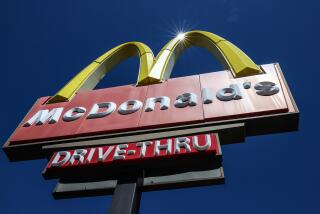Column: A strong endorsement of the $15 minimum wage from the Congressional Budget Office
The Congressional Budget Office, that nonpartisan arbiter of the impacts of federal legislation, reports that raising the federal minimum wage to $15 an hour would increase the wages of 27 million Americans and lift 1.3 million out of poverty as of 2025.
The CBO also says that the change might cost jobs for 1.3 million workers, though that’s the squishiest part of the agency’s analysis. Overall, the CBO says, “For most low-wage workers, earnings and family income would increase, which would lift some families out of poverty.”
The analysis, which was released Monday, is especially timely because House Democrats are on the verge of bringing a minimum wage raise to the floor for a vote. The Raise the Wage Act, introduced in January by Rep. Bobby Scott (D-Va.), would increase the federal minimum to $15 an hour from the current $7.25 in stages over five years.
For most low-wage workers, earnings and family income would increase, which would lift some families out of poverty.
— Congressional Budget Office, on the effect of a higher federal minimum wage
Worker advocates say the increase is long overdue. The federal minimum wage hasn’t been increased since July 2009. Accounting for inflation it peaked in 1968, when its nominal value was $1.60, the equivalent of $9.42 today by the CBO’s reckoning.
By that standard, the federal government has fallen way behind most states. As the CBO observes, 29 states and the District of Columbia now have a minimum wage higher than the federal minimum. (In those states, the higher rate applies.) The CBO points out that the minimum wage is inflation-indexed in 17 of those states. In some municipalities, the minimum wage is even higher than their state level — in San Francisco, the minimum increased to $15.59 per hour on July 1, while the California statewide rate is $12.
The CBO also reports that “about 60% of all workers currently live in states where the applicable minimum wage is more than $7.25 per hour.”
These figures give the lie to the Trump administration’s opposition to the minimum wage increase. As we reported in May, that opposition was expressed by Labor Secretary Alex Acosta, who explained fatuously to a congressional committee that raising the federal minimum would be tantamount to allowing the 29 states that have raised their minimums above the federal level to “impose their cost structures on the remaining 21 states.”
Acosta’s solicitude for those 21 laggards should be weighed against the fact that today’s federal minimum wage is close to a historical nadir for the U.S. It’s now about one-third of the median full-time wage, or the lowest in the industrialized world, where the level tends to be 50% to 60% of the median wage.
(Acosta’s days as chief underminer of worker benefits in the Trump administration may be numbered, thanks to his role as a former federal prosecutor in arranging a wrist-slap plea deal in 2008 for accused sex trafficker Jeffrey Epstein; victim rights advocates and many Democrats are calling for him to be fired.)
The CBO’s latest analysis makes clear that the benefits of a $15 minimum wage would heavily outweigh the downside. The ratio of those who would experience a higher wage vs. those who would lose their jobs or hours is about 21 to 1 (27.3 million winners, 1.3 million losers). The net gain for all workers would be $44 billion.
Who would pay for the higher earnings? Mostly business owners, and consumers to the extent businesses passed along the costs. That amounts to something of a concealed improvement in income inequality; the CBO estimates that the vast bulk of the reduced income would fall upon households earning six times the federal poverty line or more — $158,000 or more for a family of four. That stratum includes business owners paying their workers more.
As is usually the case, opponents of the raise have seized on the job loss figure. (Fox Business Network: “CBO predicts staggering job loss.”) Even middle-of-the-road news organizations seem to think the job losses are more important than the vastly broader gains. Politico calls the result “a mixed bag for House Democratic leaders,” which takes the on-the-one-hand-on-the other-hand formula a little too far.
The job loss estimates are manifestly more uncertain than most of the rest of the CBO analysis, as the agency acknowledges. The CBO says its estimate of job losses falls within a range of zero losses to 3.7 million. But as Jared Bernstein of the Center on Budget and Policy Priorities observes, the CBO’s chosen figure of 1.3 million lost jobs is not the midpoint of that range — it’s much closer to the zero estimate.
That’s significant, because most economic models of a minimum wage increase find little or no job loss effect. Indeed, surveys in communities that have instituted even major increases in the minimum, such as Seattle, haven’t detected a job-loss trend. “CBO’s assessment of the literature has simply not yet caught up,” argues Heidi Shierholz of the pro-labor Economic Policy Institute.
The CBO last examined the impacts of a rise in the minimum wage in 2014. Its conclusions were the same in principle, though smaller in absolute numbers. Conservatives also played up the job losses then — a reduction of 500,000 workers vs. higher wages for 16.5 million.
Since then, more states and more communities went ahead with increases in the minimum wage, because they recognize that it’s good for the overall economy and an expression of basic social fairness. And, again — long, long overdue.
Keep up to date with Michael Hiltzik. Follow @hiltzikm on Twitter, see his Facebook page, or email michael.hiltzik@latimes.com.
Return to Michael Hiltzik’s blog.







